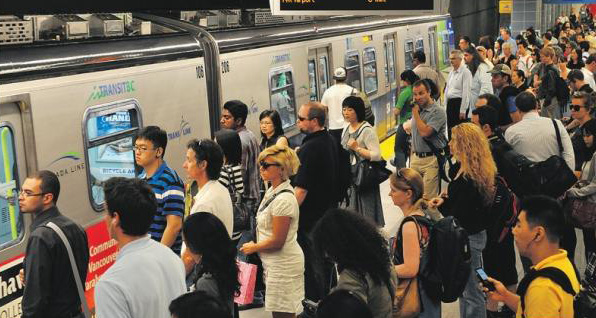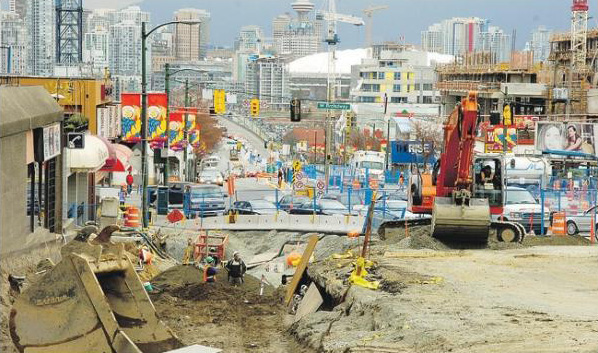Next stop: Construction controversy
Frank Luba
Province

Commuters are seen on the platform at Waterfront station. The one-year-old Canada Line has enjoyed solid ridership numbers, and the City of Vancouver is now planning the redevelopment of the entire Cambie corridor. Experts say that well-designed density around the stations is key to increasing future ridership. Photograph by: Steve Bosch, PNG, The Province

Construction could again become a familiar sight along the Canada Line. Photograph by: Jason Payne File — PNG, The Province
One year after the opening of the $2-billion Canada Line, commuters are hopping the rapid-transit link between Richmond and Vancouver in massive numbers — and the people who planned it are crowing about how lovingly the once-controversial line has been embraced.
The latter group should probably strap themselves in. Because their ride is about to get a whole lot rougher.
The construction dust has barely had a chance to settle in the year since Aug. 17, 2009, when the line began operation.
But it will soon begin to stir again as development chases after the more than 100,000 riders who now use the 19-kilometre line every day. The push will be especially strong along its low-density residential leg through Vancouver.
The debates over what will be built to house people within striking distance of Canada Line stations — how that housing will look, where it will be, how significantly it will affect the existing neighbourhoods — promise to be as lively as the original arguments about the line, its cost and its construction methods.
The City of Vancouver began studying the entire Cambie corridor well before the Canada Line opened, with council adopting a set of “planning principles” and an “interim rezoning policy” in January of this year.
That’s not just bureaucratic bafflegab. Planning is turning into reality, and fast.
There’s already one enormous project contemplated under the Cambie Corridor Planning Program: the bulky Marine Gateway at the foot of Cambie Street and Marine Drive. Critics fear the tallest tower could reach 35 storeys.
It would be the biggest building in the city outside the downtown core. And it’s creating controversy among neighbours concerned about having 483 residential units (both condominiums and rental units), retail facilities (such as grocery and drug stores), a cinema and offices all dumped into their corner of the city.
Gudrun Langolf, president of the Marpole Oakridge Area Council Society, says she’d prefer a park on the site. If it must be developed, she says, she’d prefer something on a smaller, more “human” scale.
“I believe Marpole is one of the last neighbourhoods being targeted by the developers,” says Langolf. “I think people are very wary of what is being dumped in the neighbourhood.”
Jo-Anne Pringle co-founded the Marpole Area Residents’ Association created in June to find out more about development in the neighbourhood.
“There is a feeling in our community that there is a sense of panic to hurry and densify all along the Cambie Corridor,” Pringle told The Province.
“Now that the [Canada Line] is here, I think most residents all along the line expect development to take place around the stations, but this sense of panic seems to be causing the public consultation process to be shoved aside,” she said. “This type of process isn’t only a concern for Marpole, but for any area in Vancouver that is now, or will be facing development or redevelopment.”
Pringle is right about the sense of haste.
Vancouver Coun. Geoff Meggs admits the Cambie corridor has become a “priority” for the city.
The massive Marine Gateway development has yet to come before council for rezoning, but one stormy public meeting has already been held and another is set for September.
Planning staff opposed the Marine Gateway from the beginning, because the property is zoned industrial and isn’t far from the city’s waste-transfer station.
Langolf says the smell from the garbage is “very strong,” depending on the prevailing wind.
But Meggs says council made the decision to overrule staff.
“The opportunity to develop on a transit site like that is too good to pass up, so we have to mitigate any impacts,” Meggs says.
“The other side of the coin is [that] the community, which includes Marpole, has raised real questions about the height and the amount of density,” he says.
The city can expect more of the same concern as housing densifies all along the line, Meggs admits.
“I think it’s fair to say that in all of these cases, you’re going to see that tension play out, because all along the Cambie corridor is mostly residential,” he says.
Brent Toderian, Vancouver’s director of planning, is working with the developers of Marine Gateway to ease the residential component of the project onto industrial land — and he says he’s optimistic about the outcome.
“It’s been a very challenging process for us, because this is a first for Vancouver with a project of this scale outside the downtown area,” he says.
“It’s not a surprising application, because of the Canada Line. This is what significant transit infrastructure does. It changes the assumptions for what happens around it.
“It can be a challenge, but let’s be clear, it’s also a very good thing. The reason why we’re motivated to find well-designed solution to this is [that] putting mixed-use density, density done well, around station areas is a key component to increasing ridership, decreasing our carbon footprint and helping us become, as our goal states, the greenest city in the world by 2020.
“It may be tough, but it’s worth doing.”
Gateway is just one of the projects being contemplated for the Marine and Cambie area. Others are expected to surface north along the line at King Edward, Oakridge and Langara.
The density debate isn’t really about convincing people to use the line. Average ridership has already hit levels not initially expected until 2013.
WAS THE CANADA LINE THE BEST USE OF TRANSIT DOLLARS?
After the rousing success of the line, particularly during the 2010 Winter Olympics, it’s hard to remember that the Canada Line was controversial.
In spite of shiny trains and sparkling ridership, University of B. C commerce professor Tsur Somerville still isn’t convinced the line was the right thing to do.
“They put it along the right corridor,” says Somerville, director of the Centre
for Urban Economics and Real Estate at the Sauder School of Business. “Cambie is the correct place to put a rapid transit line going from Richmond to Vancouver.
“[But] I do not feel that a subway-system investment was the best use of transit funds for the transit challenges in the Lower Mainland,” adds Somerville, who lives near the King Edward station and owns property there that will likely grow in value.
“It’s an extremely expensive investment,” he says. “The biggest public transit challenge is moving people from suburb to suburb, particularly in the [Fraser] Valley.
“Moving people from the airport and Richmond into Vancouver was not the biggest, most pressing transit issue in my mind. To a great extent, what they did was take everybody riding on buses along Granville from the suburbs and Richmond and put them on a transit line.”
But Somerville is aware of the political machinations that got the shovels into the ground for the Canada Line.
The line is a unique mix of federal government contributions ($450 million), provincial money ($370 million), airport money ($300 million), funding from regional transportation authority Trans-Link ($370 million) and from the private sector ($700 million).
The province’s money was dependent on the project being a public-private partnership. And Victoria wanted it built before the 2010 Winter Olympics.
Unlike the skeptical Somerville, Trans-Link CEO Ian Jarvis prefers to take the “long-term view” of the Canada Line.
“An investment like this really helps us achieve our long-term objectives for the region,” says Jarvis, who says that maintaining livability and economic viability in the region requires an effective transportation network.
There were other, and possibly more pressing, rapid-transit needs — the long-delayed Evergreen Line to Coquitlam, as well as an extension in Surrey and on the Broadway corridor in Vancouver, he admits.
“They’re all priorities,” Jarvis says. “We got a check mark beside one. Isn’t that good?”
Roberta Napoleao thinks so.
She and her family were visiting sister Renata from Brazil recently, and their entire party of five hauled nine bags, including a baby stroller, to the airport for their trip home.
They even had to walk three blocks to a SkyTrain station to get over to the Canada Line.
“It wasn’t easy to carry the bags on the street,” concedes Napoleao, who still thinks that “the Canada Line is very good.”
Vancouver resident Gerold Kuklinski, who normally drives to the airport (and everywhere else), agrees. The 74-year-old decided to give transit a try to see his daughter off on a recent flight, he says.
“I think it’s fantastic. It should have been done 10 years ago or more,” says Kuklinski, who notes that he wasted time and spent $12 on parking the last time he drove to pick a friend up at the airport. His tab on the Canada Line was the concession fare of $2.50.
In fact, Vancouver’s airport is probably the most prominent beneficiary of the Canada Line.
About 15 per cent of the people coming to or from YVR are using public transit, compared to just three per cent before the Canada Line opened, says airport communications director Rebecca Catley.
Other beneficiaries? Shopping at malls
along the line is suddenly easier, as is going to the River Rock Resort Casino just across the street from the Bridgeport Station.
Howard Blank, vice-president of Great Canadian Gaming, said visits to River Rock are up by 10 per cent.
The Oakridge Centre mall has seen an increase in business of around 10 per cent after the Canada Line, according to general manager Kathy Barr.
Worst off? There are more than 1,500 cabs in the Lower Mainland and of that total, 525 service YVR, says B.C. Taxi Association president Mohan Kang.
Kang says no official figures have been compiled, but he’s heard that business is off as much as 30 per cent. He thinks that might be right, given that ridership on the line is booming and that some of those riders clearly used to take cabs.
“We’re not against the Canada Line,” he says. “We’re just saying it has hurt the taxi industry.” [email protected]
THE NUMBERS
– Average weekday ridership has topped 100,000 people for the last four months, according to TransLink. That wasn’t forecast to happen until 2013.
– Daily averages, factoring in lower-ridership weekends, are almost at 100,000 as well, hitting 99,210 in July.
– Big numbers mean the break-even financial point for the line could come in 2020, three years ahead of the projected 2023.
– High numbers and crowded platforms don’t mean more trains. There are no immediate plans for buying additional trains, but TransLink has budgeted for pulling two cars out of the “spares” garage, bumping the fleet to 16 cars in August of 2011 and increasing capacity by 12 per cent.
© Copyright (c) The Province

Wellwritten and well researched article.Two points not mentioned are:
1–the significant shading of large areas around the proposed development,including homes, schools,
parks ,and boulevards ,all of which will be deprived of vital sunlight
2–the voice of neighbourhood residents is almost totally disregarded as the City,without ANY
pre-election announcement ,decides to replace the neighbourhood development concept with the
new “corridor concept ” which ignores residents’ concerns and favours developers who can then be
irresponsible since they are not committed to the neighbourhood, and can easily play the
Here Today / Gone Tomorrow two-step with — residents holding the bag for correcting costly
mistakes or enduring them, while the approving officials move on to greener pastures .